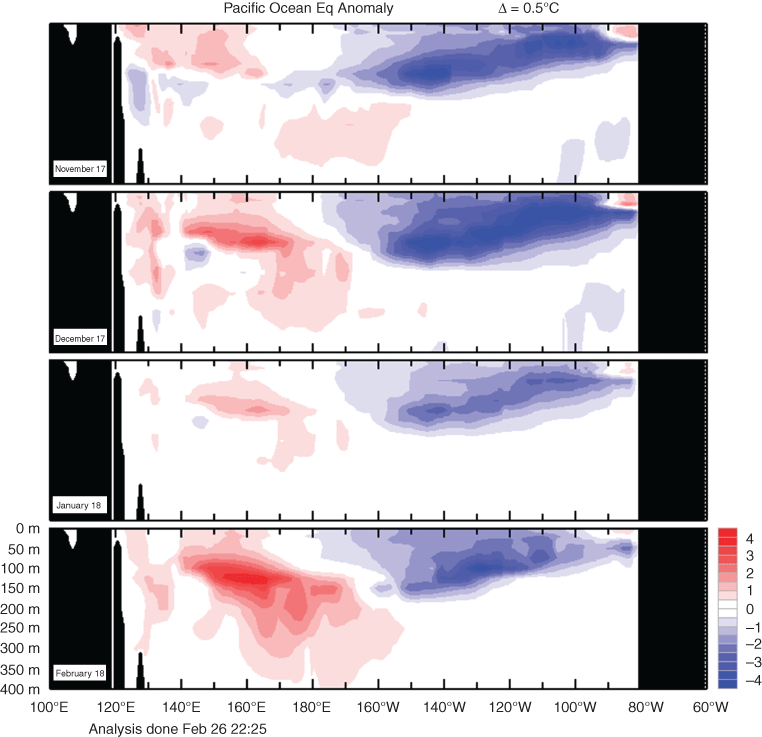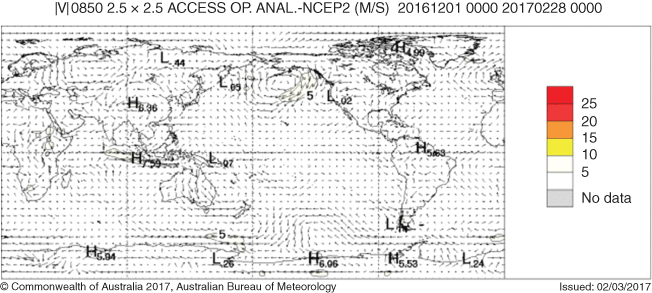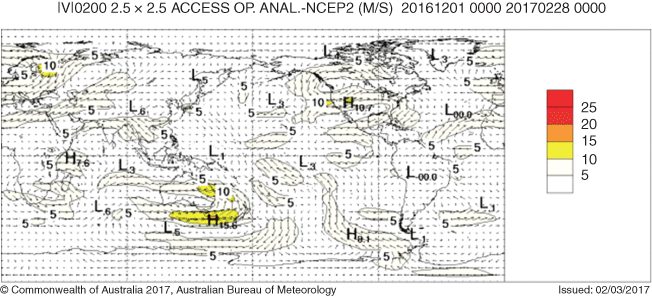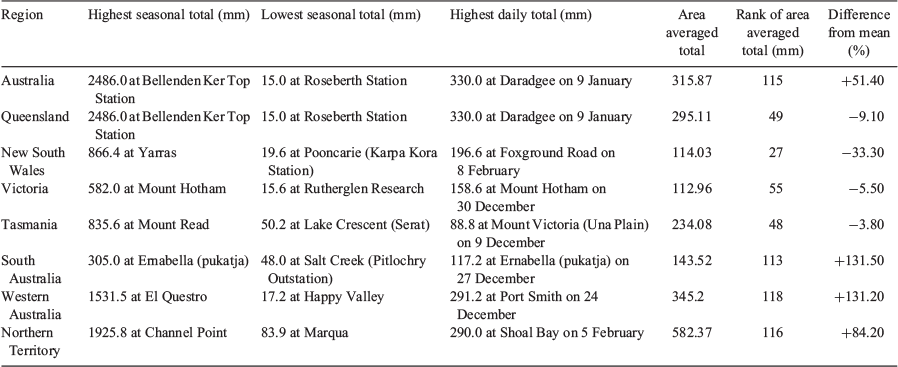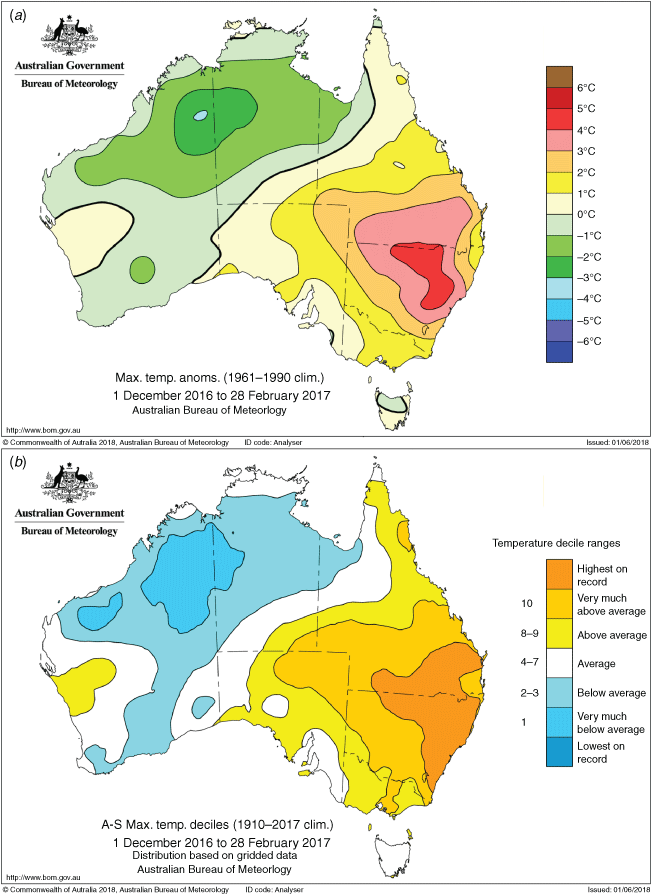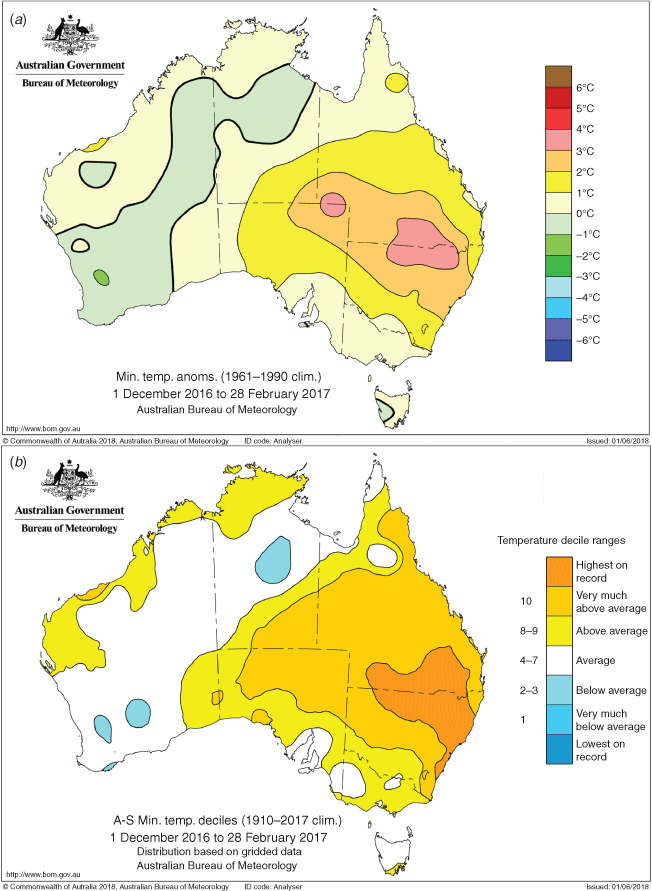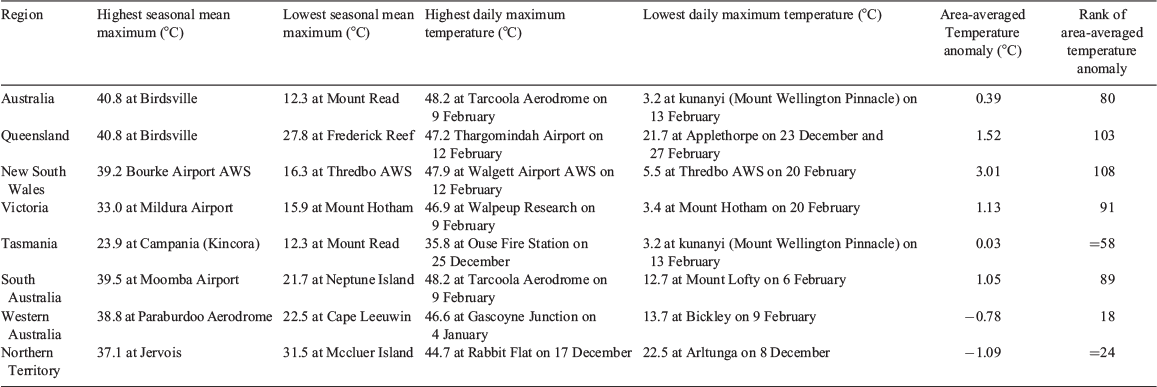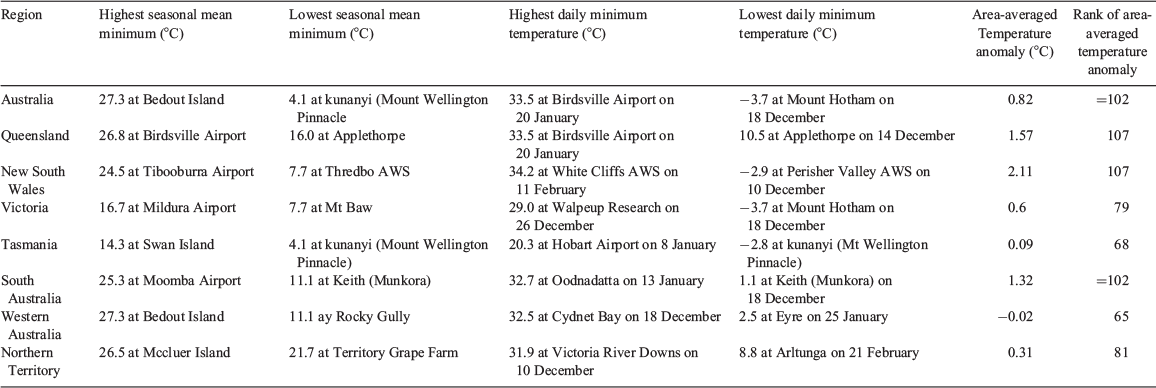Seasonal climate summary for the southern hemisphere (summer 2016–17): a season of extremes despite neutral ENSO, IOD
Ben Hague A B CA Bureau of Meteorology, GPO Box 1289, Melbourne, Vic. 3001, Australia.
B School of Earth, Atmosphere and Environment, Monash University, Clayton, Vic., Australia.
C Corresponding author. Email: ben.hague@bom.gov.au
Journal of Southern Hemisphere Earth Systems Science 69(1) 290-309 https://doi.org/10.1071/ES19005
Submitted: 4 December 2018 Accepted: 9 April 2019 Published: 11 June 2020
Journal Compilation © BoM 2019 Open Access CC BY-NC-ND
Abstract
This is a summary of the southern hemisphere atmospheric circulation patterns and meteorological indices for summer 2016–17; an account of seasonal rainfall and temperature for the Australian region is also provided. Although indices for the El Niño–Southern Oscillation (ENSO) and the Indian Ocean Dipole (IOD) represented typical neutral condition for these drivers, evidence of other climate drivers can be found in the land, ocean and atmosphere data from this time. The Southern Annular Mode appeared to have had some effect on rainfall in the east of Australia, and the Madden–Julian Oscillation active periods produced heavy rain in the tropical north. Despite neutral ENSO and IOD, extreme temperatures, in some areas highest on record, occurred in northern NSW and southern Queensland. High sea-surface temperatures caused further severe bleaching on the Great Barrier Reef.
1 Introduction
This summary reviews the southern hemisphere and equatorial climate patterns for summer 2016–17, with primary focus given to the Australasian and equatorial regions of the Pacific and Indian Ocean basins. The main sources of information for this report are analyses prepared by the Australian Bureau of Meteorology and can be attributed as such unless otherwise cited. Sections 2–5 cover key climate drivers and their states as determined via various indices over summer 2016–17. Section 6 considers cloudiness and Section 7 covers oceanic parameters, including sea ice and sea level, whereas Sections 8 and 9 cover pressure and wind patterns respectively. Sections 10 and 11 document some of the impacts of these drivers and patterns on observed temperatures and rainfall in both Australia and the broader southern hemisphere.
2 El Niño–Southern Oscillation
The Troup (1965) Southern Oscillation Index1 (SOI) for summer 2016–17 is shown in Fig. 1, along with a 5-month weighted, moving average of the monthly SOI. Sustained negative values of SOI below negative seven (−7) are often indicative of El Niño episodes, whereas persistently positive values of SOI above seven (+7) are typical of a La Niña episode. As the values for December 2016–February 2017 are all less than 7 in magnitude, the SOI indicates neutral El Niño–Southern Oscillation (ENSO) conditions in the atmosphere.
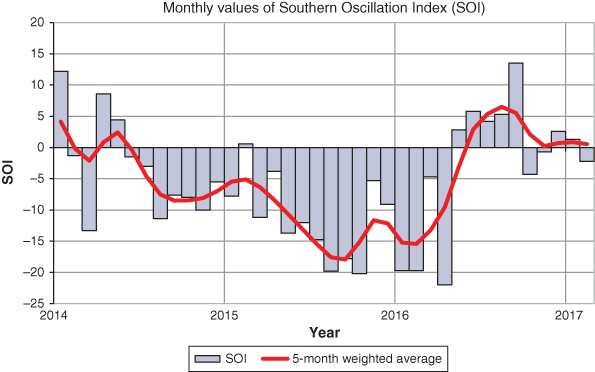
|
The NINO3.4 index, which measures SSTs in the central Pacific Ocean, between 5°N–5°S and 120–170°W, is used by the Australian Bureau of Meteorology to monitor ENSO and is closely related to the Australian climate (Wang and Hendon 2007), with positive values typically associated with El Niño events and negative values associated with La Niña events. Fig. 2 shows that this index was neutral, with values close to zero in the standardised anomaly time series in summer 2016–17, indicating near-normal conditions in the ocean.
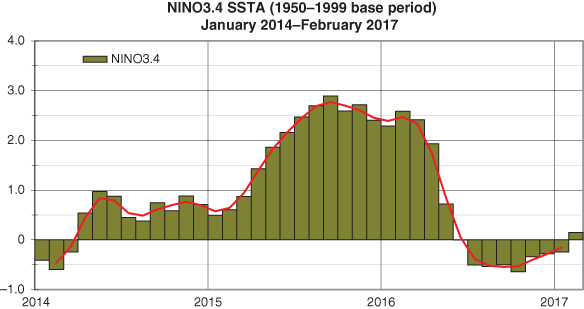
|
The ENSO 5VAR Index (5VAR2) is a composite monthly ENSO index, calculated as the standardised amplitude of the first principal component of the monthly Darwin and Tahiti mean sea level pressure (MSLP) and monthly indices NINO3, NINO3.4 and NINO4 sea-surface temperatures3 (SSTs). Values of the 5VAR that are more than 1 standard deviation are typically associated with El Niño for positive values, while negative 5VAR values of a similar magnitude are indicative of La Niña. This index is also recording near-zero values over summer 2016–17, indicating neutral ENSO conditions (Fig. 3).
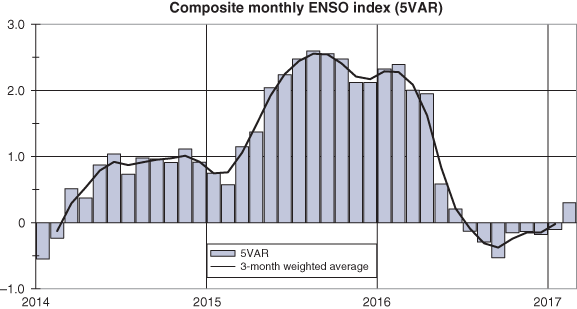
|
3 Indian Ocean Dipole
The Indian Ocean Dipole (IOD)5 is the difference in ocean temperatures across the tropical Indian Ocean. The Dipole Mode Index (DMI) is used to measure the phase and strength of the IOD and is calculated as the difference in area-averaged SSTs between a western node off the coast of Somalia and an eastern node off the coast of Sumatra. The IOD is said to be in a positive phase when the values of the DMI are greater than 0.4°C, neutral when the DMI is sustained between −0.4 and 0.4°C and negative when DMI values are less than −0.4°C.
When under the influence of a strongly negative IOD phase, warm maritime air is driven eastwards across the continent, leading to negative IOD typically being associated with an increased chance of a wetter than average spring and, or, winter for much of the continent. Negative IOD events often occur in conjunction with La Niña in the Pacific Ocean,6 and positive IOD with El Niño; that the two phenomena are related is acknowledged, but the relationship between ENSO and the IOD is complicated and continues to be an active area of research. An IOD event of positive or negative phase may have a significant influence on rainfall regimes for Australia.
The IOD, and hence its influence on Australian climate, is typically weak during December to April. This is due to the monsoon trough shifting south over the tropical Indian Ocean and changing the overall wind circulation, which, in turn, prevents an IOD ocean temperature pattern from being able to form. It is, therefore, unsurprising that DMI is near-zero during the period of December 2016–February 2017 (Fig. 4).
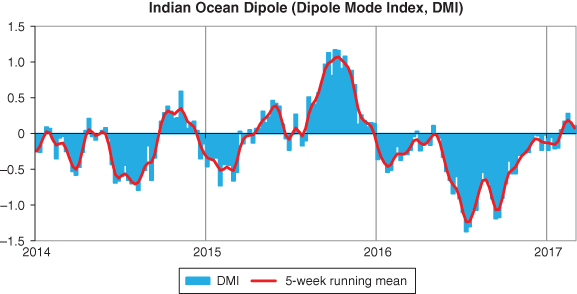
|
4 Madden–Julian Oscillation
The Madden–Julian Oscillation (MJO) is a tropical convective wave anomaly which develops in the Indian Ocean and propagates eastwards into the Pacific Ocean (Madden and Julian 1971, 1972, 1994). The MJO takes ~30–60 days to reach the western Pacific, with a frequency of 6–12 events per year (Donald et al. 2004). When the MJO is in an active phase, it is associated with areas of increased and decreased tropical convection, with effects on the southern hemisphere often weakening during early autumn, before transitioning to the northern hemisphere. A description of the Real-time Multivariate MJO (RMM) index and the associated phases can be found in Wheeler and Hendon (2004).
The phase-space diagram of the RMM for summer 2016–17 is shown in Fig. 5. During December 2016 the MJO Index did not move outside of the unit circle, indicating weak MJO conditions during that period. The magnitude of the MJO Index increased throughout January, reaching its peak in mid-February in phase 8, remaining strong for the rest of month. Interestingly, the highest value experienced in phase 5 coincided with the wettest day in the December–February period for the Northern Territory, which exemplifies the expected rainfall impacts for that region in that phase of the MJO as identified by Wheeler et al. (2009).
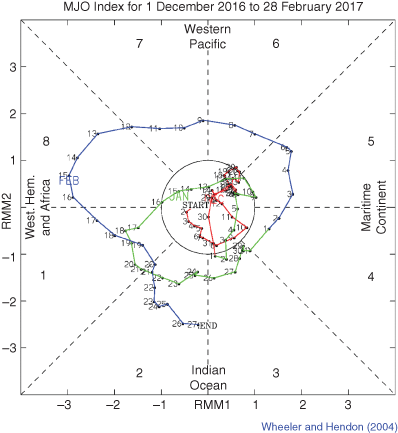
|
5 Southern Annular Mode
The Southern Annular Mode (SAM) is a recurring pattern of circulation anomalies in the mid- and high latitudes of the southern hemisphere that is characterised by the changing latitudinal position of the strongest westerly winds near southern Australia and influences the strength and position of cold fronts and mid-latitude storm systems. It is, therefore, an important driver of rainfall variability in southern and eastern Australia. The Marshall (2003) SAM index indicates that the negative phase of SAM prevailed over the summer of 2016–17 with values of −1.52, −1.12 and −1.09 for December, January and February respectively (data from https://legacy.bas.ac.uk/met/gjma/sam.html, accessed 27 April 2020).
A negative phase of SAM in summer is typically associated with reduced rainfall in eastern Australia as the poleward progression of the subtropical ridge and westerly wind belt results in dry continental air being more likely to be advected eastward, reducing the influence of the moist tropical north-easterlies (Hendon et al. 2007). The SAM is, therefore, a potential explanation of the rainfall pattern observed in eastern Australia in summer 2016–17, described in Section 10.1. The average summer value of SAM, calculated as a simple average of the three constituent months’ Marshall (2003) averages, was the most negative since 2005 and second most negative over the preceding 30 years (Fig. 6).
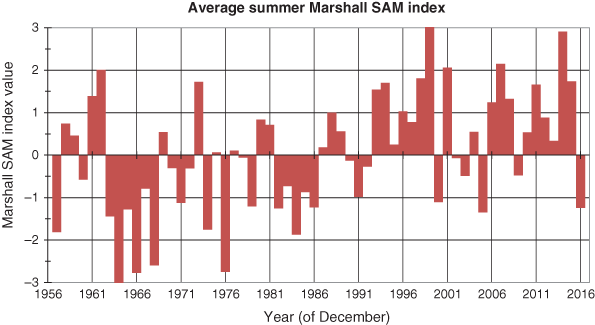
|
6 Cloudiness: outgoing longwave radiation
Outgoing longwave radiation (OLR) in the equatorial Pacific Ocean can be used as an indicator of enhanced or suppressed tropical convection. Increased positive OLR anomalies typify a regime of reduced convective activity, a reduction in cloudiness and, usually, rainfall. Conversely, negative OLR anomalies indicate enhanced convection, increased cloudiness and chances of increased rainfall. During La Niña, decreased convection (increased OLR) can be seen near the Date Line, while increased cloudiness (decreased OLR) near the Date Line usually occurs during El Niño. Similarly, when Australia is under the influence of a negative IOD event, OLR anomalies are negative over the eastern Indian Ocean where increased convection occurs.
The Hovmöller diagram of OLR anomalies along the equator during summer 2016–17 (Fig. 7) shows modest positive OLR anomalies near the International Date Line, with the area-averaged (over 7.5°S–7.5°N and 160–160°E) monthly OLR anomalies for December 2016, and January and February 2017 were 21.2, 16.5 and 21.5 respectively.7 Seasonal spatial patterns of OLR anomalies for summer 2016–17 globally, and across the Asia-Pacific region, between 40°S and 40°N, are shown in Figs 8 and 9 respectively. Most of northwest Australia has large negative anomalies, indicating increased cloudiness and rainfall. This corroborates well with surface-based observations of precipitation in the area (refer Section 10.1), being well above average, over a similar base period.
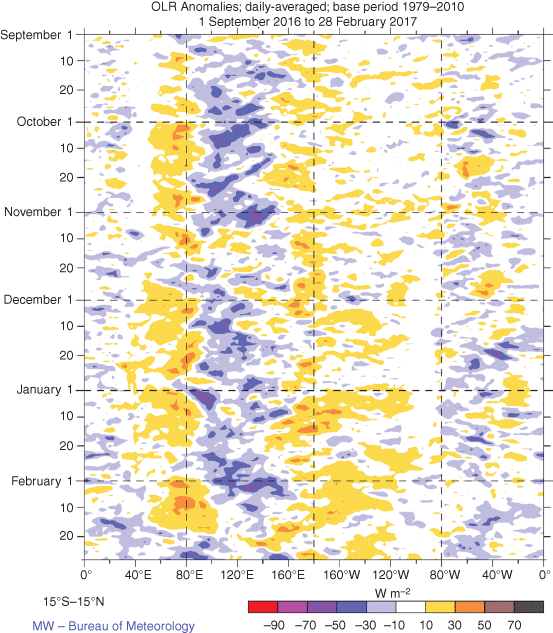
|
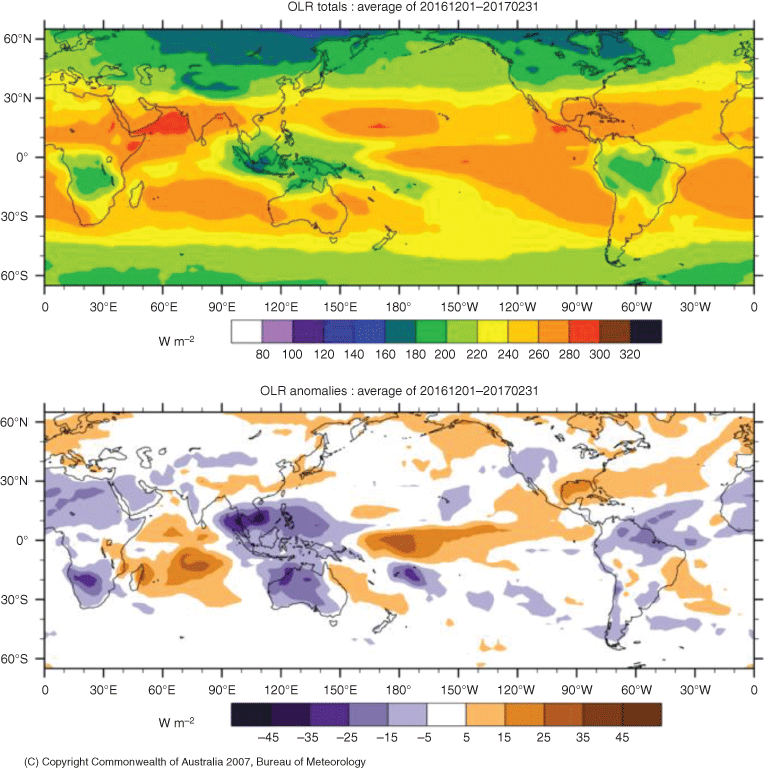
|
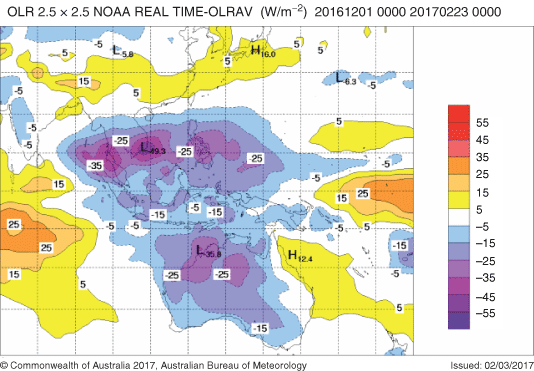
|
7 Oceanic patterns
7.1 Temperature
The SST for the combined ocean area of the southern hemisphere for summer 2017–18, were overall 0.63°C above the 20th century average, the second highest on record (record begins 1881) after the summer of 2017–18.8 Globally, ocean temperatures were also the second warmest on record for the austral summer months, 0.66°C above the 20th century average. Figure 10 shows these anomalies spatially. SST anomalies in the Australian region were 0.32°C above the 1961–90 average. Note that the 1900–99 average is ~0.18°C less than the 1961–909 average, so the Australian region SST anomaly is closer to the global and hemispheric average than the value suggests. The SST deciles for the Australian region are depicted in Fig. 11. SSTs was above average in areas of the central and southern parts of the Great Barrier Reef (south of Cooktown) over the summer (and early autumn) of 2016–17, which resulted in severe coral bleaching between Cooktown and Townsville (Hughes and Kerry 2017). This followed the third largest on record bleaching event that occurred over the previous summer, which resulted in widespread sever bleaching north of Cooktown (Hughes et al. 2017). These sequential events resulted in two-thirds of reef having suffered bleaching during either the 2015–16 event, the 2016–17 event or both.
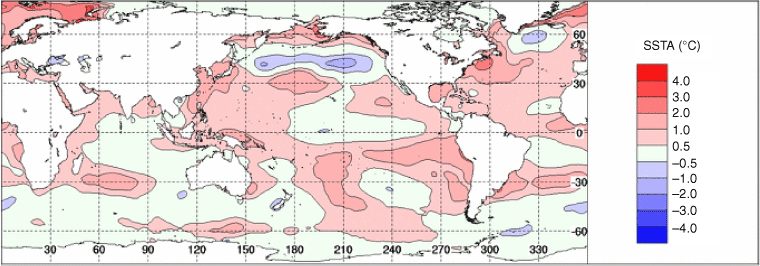
|
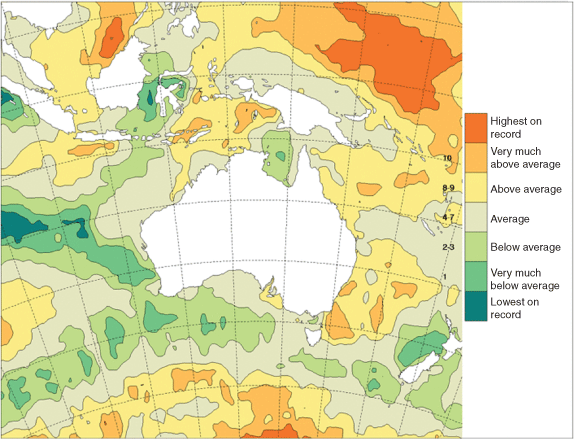
|
The 20°C isotherm depth is generally located close to the equatorial thermocline, which is the region of greatest temperature gradient with depth and is the boundary between the warm near-surface and cold deep-ocean waters. Therefore, measurements of the 20°C isotherm depth make a good proxy for the thermocline depth. Negative anomalies correspond to the 20°C isotherm being shallower than average and is indicative of a cooling of subsurface temperatures. If the thermocline anomaly is positive, the depth of the thermocline is deeper. A deeper thermocline results in less cold water available for upwelling, and therefore a warming of surface temperatures. Fig. 12 shows the 20°C isotherm depth with longitude over the December 2016–February 2017. The thermocline was generally deeper between 160°E and 160°W and shallower than usual further east, especially from mid-January into February.
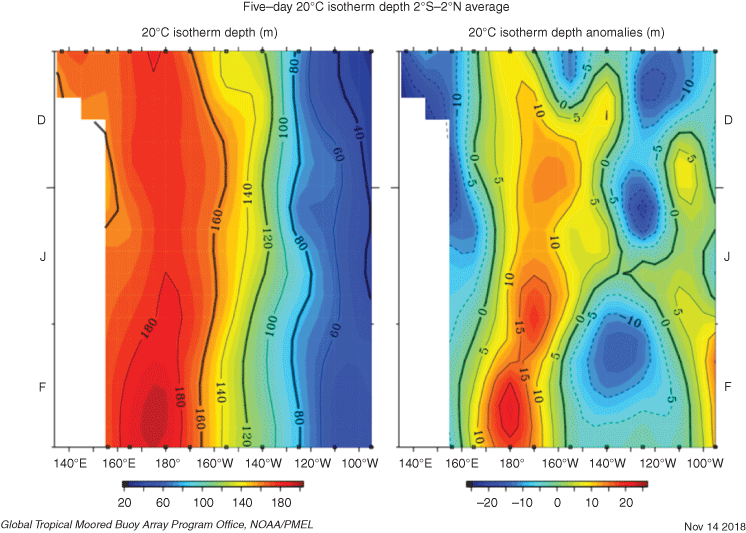
|
Fig. 13 also shows this general pattern of subsurface warming in the western Pacific from mid-January to February with warm and cool anomalies of maximum magnitude of ~3–4°C, establishing themselves in the west and east Pacific respectively, at a depth of ~100 m.
7.2 Sea ice
February 2017 southern hemisphere sea ice extent was the lowest since records began in 1979, at 2.29 million km2, based on NASA Goddard Data10 (February 2018 levels were equal to those in 2017, making it now equal lowest on record). This is 0.78 million km2 (or 34%) below the long-term February average. January 2017 (3.78 million km2) and December 2016 (8.28 million km2) were also the lowest on record for their respective months in terms of ice extent.
7.3 Sea level
Sea levels were overall above average in the South Pacific and Australian region for all months in the austral summer of 2016–17. Southern Indian Ocean sea levels were also mostly above average. Sea-level anomalies are shown in Fig. 14 and refer to a datum of mean sea surface height from 1993 to 2017. Strong positive anomalies were prominent in the Tasman Sea near the NSW coast, the Gulf of Carpentaria and the western Torres Strait. These strong positive anomalies are also apparent in coastal tide gauges that are part of the Bureau of Meteorology’s high-quality Australian Baseline Sea Level Monitoring Project. Groote Eylandt, in the Gulf of Carpentaria, recorded its ninth-highest monthly mean sea level (out of 281 months) in February 2017. Port Kembla, on the south coast of NSW, recorded its 25th- and 27th-highest monthly mean sea levels (out of 308 months) in January and February 2017 respectively. Considering the mean of the individual monthly averages as an approximate seasonal average, Port Kembla experienced the highest average summer sea levels since the 1991 installation (Fig. 15). Using the same metric, Groote Eylandt was 7th highest out of 21 summers.

|
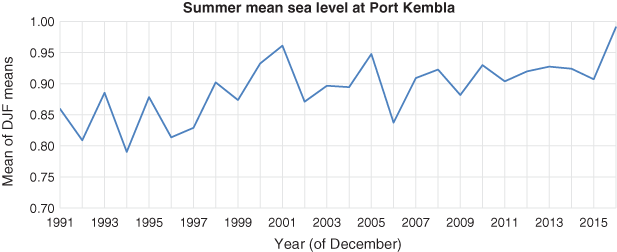
|
8 Atmospheric circulation
8.1 Surface analyses
The MSLP pattern for summer 2016–17 is shown in Fig. 16, computed using data from the 0000 UTC daily analyses of the Bureau of Meteorology’s Australian Community Climate and Earth System Simulator (ACCESS) model. MSLP anomalies are shown in Fig. 17, relative to the 1979–2000, climatology obtained from the National Center for Environmental Prediction (NCEP) II Reanalysis data (Kanamitsu et al. 2002). The MSLP anomaly field is not shown over areas of elevated topography (grey shading). This reflects the negative SAM conditions as the low-pressure belt that is usually centred near the edge of Antarctica is further equatorward than usual, indicated by low pressure anomalies ~50oS and high-pressure anomalies at the pole and over the Australian continent.

|
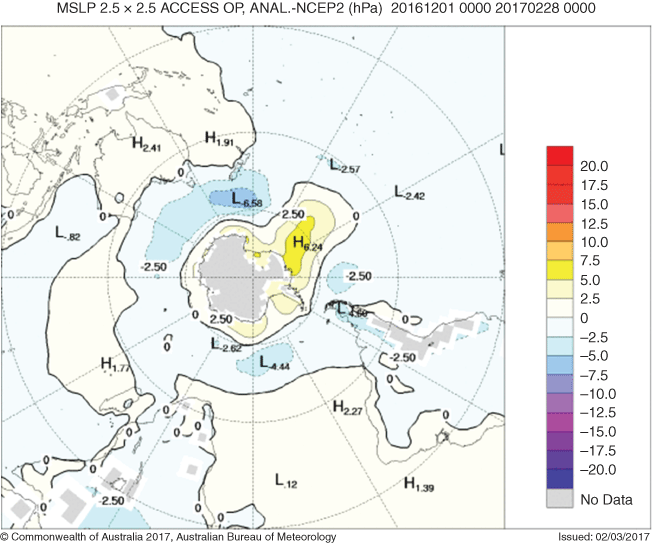
|
8.2 Midtropospheric analyses
The 500 hPa geopotential height, an indicator of the steering of surface synoptic systems across the southern hemisphere, is shown for summer 2016–17 in Fig. 18. The associated anomalies are shown in Fig. 19. Geopotential height is valuable for identifying and locating features like troughs and ridges which are the upper level equivalents of surface low- and high-pressure systems respectively. These plots exhibit similar patterns to the surface-level plots (Figs 16 and 17), with a belt of below-average geopotential ~50°S, and above-average geopotential at the pole and over Australia
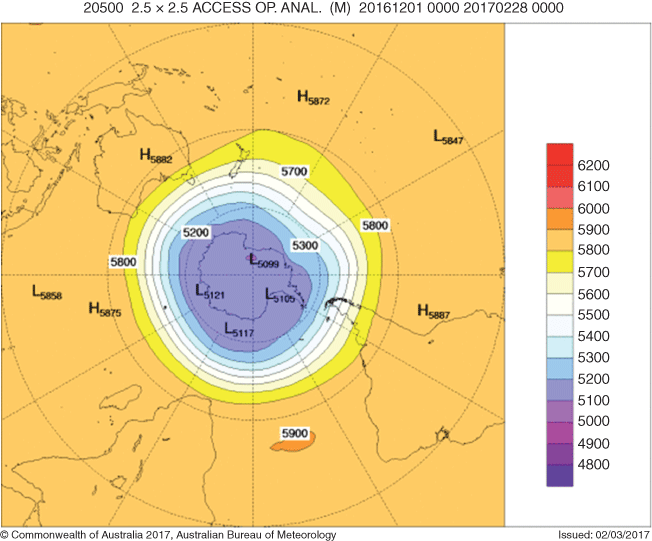
|
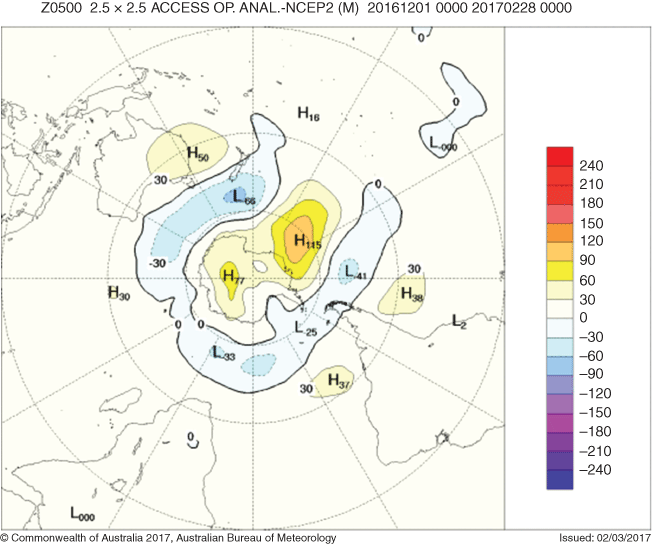
|
9 Winds
Figs 20 and 21 show summer 2017–18 low-level (850 hPa) and upper level (200 hPa) wind anomalies respectively (winds computed from ACCESS and anomalies with respect to the 22-year 1979–2000 NCEP climatology). Isotach contours are at an interval of 5 m s−1. There are strong upper level westerly wind anomalies over southern Australia, a pattern associated with a stronger mid-latitude jet and one that has also been linked to the negative phase of the SAM (Lim et al. 2013).
10 Australian region
December was warmer than average for Australia especially in the east, with the monthly average national temperatures 0.71°C above average, with anomalies of +0.46°C in mean maximum and +0.96°C in minima. It was the fifth-wettest December on record primarily due to large (third highest on record) totals in WA and NT and highest on record totals in SA. Queensland, NSW and Victoria were 10–20% drier than average, despite an event of exceptional heavy rain and humidity affecting southern Australia (documented in Special Climate Statement (SCS) 5912).
Considering monthly averages, January was similar to December. Well-above-average rainfall continued, with January 2017 recording the fourth-highest annual average rainfall of all Januarys on record, with WA, NT and SA again making the largest contributions to this figure, with third-, third- and sixth-highest Januarys on record respectively. It was 0.78°C above average in mean temperature, driven by the third-highest mean national minimum temperature anomaly on record of 1.29°C, with the biggest contributions to this figure from QLD, NSW and SA which recorded second, fourth and eighth highest on record minimum temperatures respectively. A prolonged period of extreme heat established itself in late January and continued into February in the east (SCS 6113), whereas a period of prolonged heavy rainfall occurred in the south, which persisted and produced flooding into February (SCS 6014). However, nationally area-averaged temperatures and rainfall were closer to average in February than in December and January, although Queensland and New South Wales both recorded their fifth-hottest Februarys on record.
Three key ENSO indices all reported neutral conditions in the Pacific Ocean during summer 2016–17. Combined with neutral-IOD, this left the MJO and the SAM as key drivers for this period. However, the exact role these drivers played is unclear, with eastern Australia experiencing conditions typically associated with negative SAM, but Western Australia not experiencing the below-average rainfall typically associated with this pattern, which has historically been especially pronounced when ENSO is neutral (Raut et al. 2014). Additionally, although a strong MJO in phase 5 was aligned with the highest daily rainfall totals near Darwin, it is unlikely to explain the widespread areas of above-average rainfall in northern Australia.
10.1 Rainfall
Fig. 22 shows rainfall totals and deciles for the period December 2016 to February 2017 inclusive, which shows an overall pattern of below-average rainfall in the eastern third of the country and above-average rainfall in the remainder. Table 1 documents seasonal and daily extremes for each state and the Northern Territory and places these figures in a climatological context. There were no areas of rainfall deficiency being monitored at the time, with no Drought Statements issued by the Bureau for any month. Of note is the large area of 10th-decile rainfall (‘highest on record’ and ‘very much above average’ in Fig. 22a) through much of the Northern Territory (71.1% of total area), Western Australia (70.0%) and South Australia (63.5%), with 20.2% of Western Australia recording highest on record summer rainfall. This widespread well-above-average rainfall is reflected in the national figures – 43.6% of Australia experienced 10th-decile rainfall. Despite some drier than average conditions being experienced in eastern Australia, areas of extreme dry were generally isolated, with only 2.1% of Australia recording first decile summer rainfall.
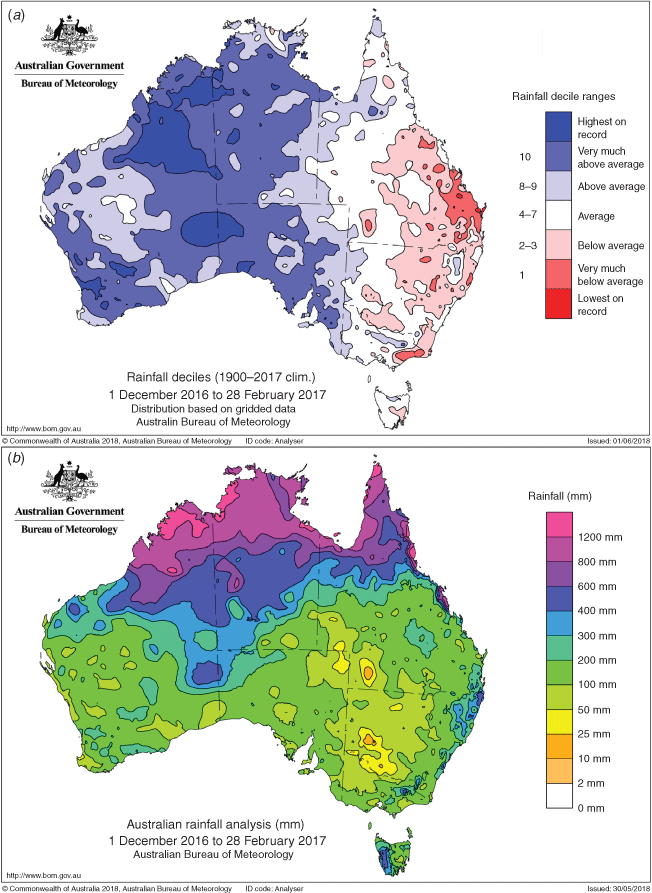
|
10.2 Temperature
The patterns of anomalies and deciles for minimum and maximum temperature demonstrated a similar east–west contrast to that in the rainfall data, with the north–west half of Australia experiencing below average maximum temperatures (Fig. 23) and near-average to above-average minimum temperatures (Fig. 24), whereas the eastern and southern parts of Australia experienced above- to well-above-average figures for both maximum (Fig. 23) and minimum (Fig. 24) temperatures. Tasmania was an exception to this, experiencing near-average conditions for both minimum and maximum temperatures over the 3-month summer period.
Extreme maximum temperatures were most concentrated in New South Wales and Queensland, with 89.3% and 49.7% of those states recording 10th decile (i.e., top 90% of the record) seasonal average maximum temperatures respectively. Remarkably, 44.1% of New South Wales experienced the hottest summer on record, including the populated coastal zone. A total of 15.5% of Queensland also experienced highest on record average summer maximum temperatures. Areal decile exceedance coverage was similar for minimum temperatures with 80.0% of Queensland and 78.3% of NSW experiencing 10th decile average summer minimum temperatures, with substantial proportions (35.5% for NSW and 13.7% for Queensland) being highest on record in that metric. By contrast, precisely 0% of Australia experienced first decile minimum temperatures, with only 6.4% of Australia recording temperatures in the bottom four deciles, substantially lower than climatological (1961–90) expectation (40% by definition). The results for maximum temperatures were more typical of an average year, with 7.8% of Australia recording first decile maximum temperatures and 40.4% in the lowest four deciles.
Tables 2 and 3 document localised extreme temperatures, both seasonally averaged and daily, in each state and the Northern Territory, and consider the climatological context of these extremes. A subset (ACORN-SAT15) of the full temperature network is used to calculate the spatial averages and rankings shown in Table 2 (maximum temperature) and Table 3 (minimum temperature). These averages are available from 1910 to the present. As the anomaly averages in the tables are only retained to two decimal places, tied rankings are possible. Rankings marked with ‘=’ denote tied rankings.
10.3 Tropical cyclones
The two most significant severe tropical cyclones (STCs) of the 2016–17 season, in terms of damage and intensity respectively, were STC Debbie and STC Ernie. However, as these cyclones occurred in March and April respectively, they are not discussed in detail in this summary. Three tropical systems warranted severe weather reports in the period from December 2016 to February 201716: Tropical Cyclone (TC) Yvette, Tropical Low 14U and TC Alfred, all which made landfall in northern Australia. TC Yvette made landfall (as a tropical low) near Broome on December 25, Tropical Low 14U, also made landfall near Broome, on January 26, and Alfred made multiple coastal crossings as a tropical low in the southwest Gulf of Carpentaria between February 17 and 22. The impacts of these systems were largely restricted minor to moderate riverine floods of local catchments due to heavy rain.
11 Southern hemisphere
Overall, the southern hemisphere experienced near-average rainfall, although deficiencies were observed in coastal South Africa and some elevated and equatorial parts of South America (Fig. 25).17 Madagascar experienced its lowest December–February rainfall on record, exacerbating the pre-existing social impacts of prolonged drought, with UNICEF (2017) reporting that ~200 000 people required emergency access to water in early 2017. By contrast, land temperatures were, aside from a small region of northwest Australia, exclusively above-average (Fig. 26). Ocean temperatures were also generally above-average, which is notable given the neutral state of the primary Indian and Pacific Ocean coupled oscillators.
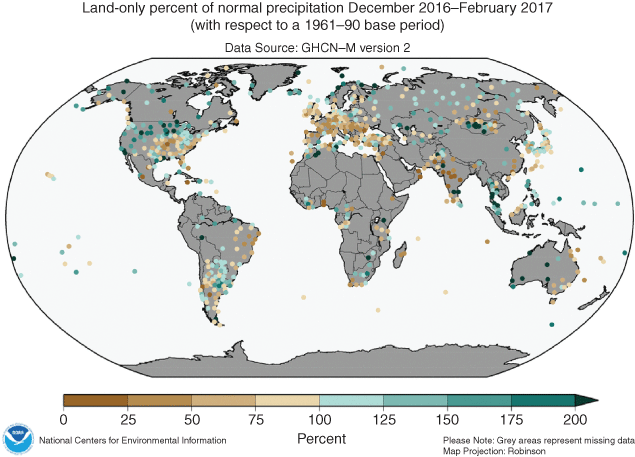
|
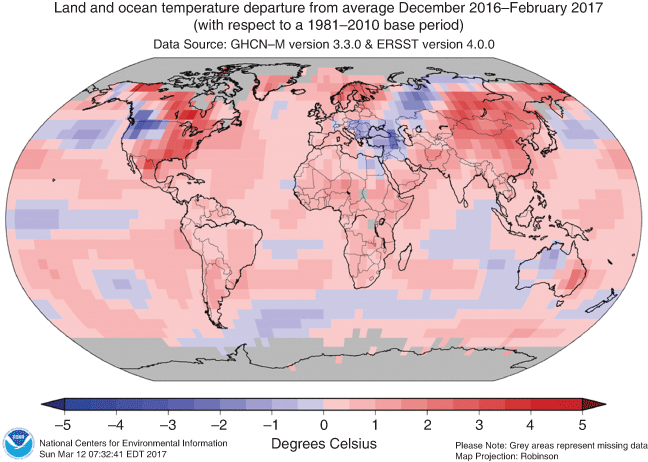
|
New Zealand’s National Institute of Water and Atmospheric Research (NIWA) summarised conditions in New Zealand for Summer 2016–17 as generally cooler than or near-average with below-average rainfall in many locations (NIWA 2017).
12 Summary
Despite oceanic and atmospheric indices showing neutral condition of the ENSO and IOD, the summer period, December 2016 to February 2017 still experienced extreme weather and climate events and their impacts. Some of these events were potentially modulated by the MJO, in the case of the timing of extreme rainfall in the tropical north, and the SAM, when considering dry conditions in eastern Australia. Notably, the Marshall (2003) SAM index recorded its second-most negative summer value since 1984 and the most negative since 2005, which appears related to observed seasonal MSLP and upper level wind anomalies. OLR plots match with near- to highest on record seasonal rainfall totals across WA, SA and NT – which combined resulted in Australia recording its (area-averaged) fourth wettest year on record (since 1900).
In the ocean, SSTs were generally above average along the east coast and below average on the southwest coast. These temperatures resulted in the second major bleaching event in the Great Barrier Reef in 2 years, with the most severe impacts, reported between Cooktown and Townsville. Sea ice was the lowest on record (since 1979) and approximately a third below the long-term February average. Sea levels were above average almost the entire southern hemisphere with large positive anomalies in the Gulf of Carpentaria and in western Tasman sea, which produced above-average sea levels at coastal tide gauges.
Overall, the southern hemisphere, experienced near-average rainfall with some isolated areas of deficiencies but widespread above-average temperatures on land and in the oceans.
Acknowledgements
The author acknowledges Greg Browning and Andrew Marshall for providing helpful suggestions as reviewers, and Matt Wheeler for supplying MJO diagrams. This research did not receive any specific funding.
References
Donald, A., Meinke, H., Power, B., Wheeler, M. and Ribbe, J. (2004). Forecasting with the Madden–Julian Oscillation and the applications for risk management. Brisbane, 4th International Crop Science Congress, 2004.Hendon, H. H., Thompson, D. W. J., and Wheeler, M. C. (2007). Australian rainfall and surface temperature variations associated with the Southern Annular Mode. J. Clim. 20, 2452–2467.
| Australian rainfall and surface temperature variations associated with the Southern Annular Mode.Crossref | GoogleScholarGoogle Scholar |
Hughes, T., and Kerry, J. (2017). Back-to-back bleaching has now hit two-thirds of the Great Barrier Reef. The Conversation [online]. Available at https://theconversation.com/back-to-back-bleaching-has-now-hit-two-thirds-of-the-great-barrier-reef-76092 [Updated 12 April 2017, verified 30 November 2018].
Hughes, T. P., Kerry, J. T., Álvarez-Noriega, M., Áclvarez-Romero, J. G., Anderson, K. D., Baird, A. H., Babcock, R. C., Beger, M., Bellwood, D. R., Berkelmans, R., Bridge, T. C., Butler, I. R., Byrne, M., Cantin, N. E., Comeau, S., Connolly, S. R., Cumming, G. S., Dalton, S. J., Diaz-Pulido, G., Eakin, C. M., Figueira, W. F., Gilmour, J. P., Harrison, H. B., Heron, S. F., Hoey, A. S., Hobbs, J.-P. A., Hoogenboom, M. O., Kennedy, E. V., Kuo, C.-Y., Lough, J. M., Lowe, R. J., Liu, G., McCulloch, M. T., Malcolm, H. A., McWilliam, M. J., Pandolfi, J. M., Pears, R. J., Pratchett, M. S., Schoepf, V., Simpson, T., Skirving, W. J., Sommer, B., Torda, G., Wachenfeld, D. R., Willis, B. L., and Wilson, S. K. (2017). Global warming and recurrent mass bleaching of corals. Nature 543, 373–377.
| Global warming and recurrent mass bleaching of corals.Crossref | GoogleScholarGoogle Scholar |
Kanamitsu, M., Ebisuzaki, W., Woollen, J., Yang, S.-K., Hnilo, J. J., Fiorino, M., and Potter, G. L. (2002). NCEP-DOE AMIPII Reanalysis (R-2). Bull. Am. Meteorol. Soc. 83, 1631–1643.
| NCEP-DOE AMIPII Reanalysis (R-2).Crossref | GoogleScholarGoogle Scholar |
Kuleshov, Y., Qi, L., Fawcett, R., and Jones, D. (2009). Improving preparedness to natural hazards: tropical cyclone prediction for the Southern Hemisphere. Adv. Geosci. 12, 127–143.
Lim, E.-P., Hendon, H. H., and Rashid, H. (2013). Seasonal predictability of the Southern Annular Mode due to its association with ENSO. J. Clim. 26, 8037–8054.
| Seasonal predictability of the Southern Annular Mode due to its association with ENSO.Crossref | GoogleScholarGoogle Scholar |
Madden, R. A., and Julian, P. R. (1971). Detection of a 40-50 day oscillation in the zonal wind in the tropical Pacific. J. Atmos. Sci. 28, 702–708.
| Detection of a 40-50 day oscillation in the zonal wind in the tropical Pacific.Crossref | GoogleScholarGoogle Scholar |
Madden, R. A., and Julian, P. R. (1972). Description of global-scale circulation cells in the tropics with a 40-50 day period. J. Atmos. Sci 29, 1109–11023.
| Description of global-scale circulation cells in the tropics with a 40-50 day period.Crossref | GoogleScholarGoogle Scholar |
Madden, R. A., and Julian, P. R. (1994). Observations of the 40-50 day tropical oscillation: a review. Mon. Wea. Rev. 122, 814–837.
| Observations of the 40-50 day tropical oscillation: a review.Crossref | GoogleScholarGoogle Scholar |
Marshall, G. (2003). Trends in the Southern Annular Mode from observations and reanalyses. J. Clim. 16, 4134–4143.
| Trends in the Southern Annular Mode from observations and reanalyses.Crossref | GoogleScholarGoogle Scholar |
NIWA (2017). Summer 2016–17. Available at https://www.niwa.co.nz/climate/summaries/seasonal/summer-2016-17 [Updated 3 March 2017, verified 19 November 2018].
Raut, B. A., Jakob, C., and Reeder, M. J. (2014). Rainfall changes over southwestern Australia and their relationship to the Southern Annular Mode and ENSO. J. Clim. 27, 5801–5814.
| Rainfall changes over southwestern Australia and their relationship to the Southern Annular Mode and ENSO.Crossref | GoogleScholarGoogle Scholar |
Troup, A. (1965). The ‘Southern Oscillation’. Q. J. R. Meteorol. Soc. 91, 490–506.
| The ‘Southern Oscillation’.Crossref | GoogleScholarGoogle Scholar |
UNICEF (2017). Madagascar El Nino Drought Humanitarian Situation Report: January–June 2017. Available at https://reliefweb.int/sites/reliefweb.int/files/resources/UNICEF%20Madagascar%20Mid-Year%20SitRep%2C% 20June%202017.pdf [Verified 19 November 2018].
Wang, G., and Hendon, H. H. (2007). Sensitivity of Australian rainfall to inter-El Niño variations. J. Clim. 20, 4211–4422.
| Sensitivity of Australian rainfall to inter-El Niño variations.Crossref | GoogleScholarGoogle Scholar |
Wheeler, M., and Hendon, H. (2004). An all-season real-time multivariate MJO index: development of an index for monitoring and prediction. Aust. Mon. Wea. Rev. 132, 1917–1932.
| An all-season real-time multivariate MJO index: development of an index for monitoring and prediction.Crossref | GoogleScholarGoogle Scholar |
Wheeler, M. C., Hendon, H. H., Cleland, S., Meinke, H., and Donald, A. (2009). Impacts of the Madden–Julian Oscillation on Australian rainfall and circulation. J. Clim. 22, 1482–1498.
| Impacts of the Madden–Julian Oscillation on Australian rainfall and circulation.Crossref | GoogleScholarGoogle Scholar |
1 The Troup Southern Oscillation Index (Troup 1965) used in this article is 10 times the standardised monthly anomaly of the difference in mean sea level pressure (MSLP) between Tahiti and Darwin. The calculation is based on 60-year climatology (1933–92), with records commencing in 1876. The Darwin MSLP is provided by the Bureau of Meteorology, and the Tahiti MSLP is provided by Météo France inter-regional direction for French Polynesia.
2 ENSO 5VAR was developed by the Bureau of Meteorology and is described by Kuleshov et al. (2009). The principal component analysis and standardisation of this ENSO index is performed over the period 1950–99.
3 SST indices obtained from ftp://ftp.cpc.ncep.noaa.gov/wd52dg/data/indices/sstoi.indices.
4 Values from http://www.esrl.noaa.gov/psd/gcos_wgsp/Timeseries/Data/nino34.long.data, verified 27 April 2020.
5 http://www.bom.gov.au/climate/iod/, verified 27 April 2020.
6 http://www.bom.gov.au/climate/iod/#tabs=Pacific-Ocean-interaction, verified 27 April 2020.
7 Data from http://www.cpc.ncep.noaa.gov/data/indices/olr, verified 27 April 2020.
8 NOAA National Centers for Environmental Information, Climate at a Glance: Global Time Series, published May 2017, retrieved on 13 May 2017 from http://www.ncdc.noaa.gov/cag/, verified 27 April 2020 (base period 1900–present).
9 Calculated from data at http://www.bom.gov.au/web01/ncc/www/cli_chg/timeseries/sst/1202/aus/latest.txt, verified 27 April 2020.
10 Available from National Snow and Ice Data Centre: https://nsidc.org/arcticseaicenews/sea-ice-tools/, verified 27 April 2020.
11 Hovmöller plot obtained from http://www.pmel.noaa.gov/tao/jsdisplay/, verified 27 April 2020.
12 Available at: http://www.bom.gov.au/climate/current/statements/scs59.pdf, verified 27 April 2020.
13 Available at: http://www.bom.gov.au/climate/current/statements/scs61.pdf, verified 27 April 2020.
14 Available at: http://www.bom.gov.au/climate/current/statements/scs60.pdf, verified 27 April 2020.
15 See http://www.bom.gov.au/climate/change/acorn-sat/ for details, verified 27 April 2020.
16 From: http://www.bom.gov.au/announcements/sevwx/, verified 27 April 2020.
17 From: https://www.ncdc.noaa.gov/temp-and-precip/global-maps/201714#global-maps-select, verified 27 April 2020.

